This week I thought I would take my cue from the events of last weekend and the idea of significant anniversaries – the international remembrance of VE Day 75 years ago and a local remembrance of Sir Roger Manwood’s foundation of his almshouses in Canterbury 450 years ago. Of course, the ceremonies and other events planned for both of these either didn’t happen at all, especially in the case of Manwood’s almshouses, or were very different than first planned, the VE Day commemoration of those who had come through WWII , but even more those who hadn’t. However, the actual focus of this blog is neither of these, and hopefully I’ll be able to report on the Manwood event next year, nor is it Becket 2020, which seems to becoming Becket 2020/21, although Becket might be said to have a walk-on part.
What I do want to explore is the idea of how and why we mark, even celebrate, anniversaries, this desire to look back into the past – to people, places and events. One of my reasons for this interest is an article I’m hoping to write once things get back to ‘normal’ on the ‘Becket mazer’ that belongs to St Nicholas’ hospital and is currently in the custody of Canterbury Cathedral. The research for this has taken me to David Lowenthal’s The Past is a Foreign Country. Revisited and to the Canterbury Chapter Meeting minute books of the 1970s and 1980s, held at Canterbury Cathedral Archives & Library.
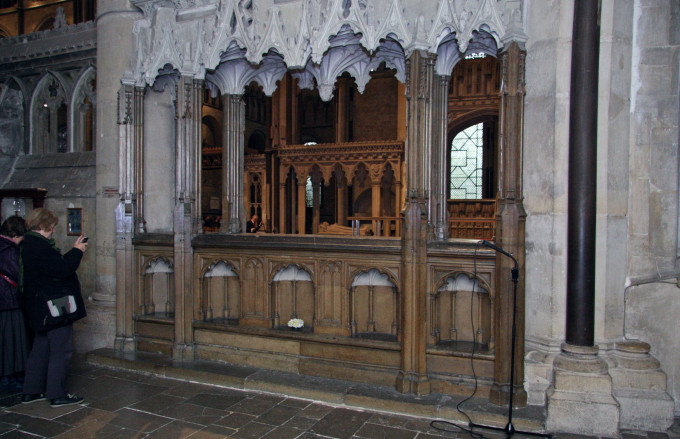
Now to put what I found in the Chapter minutes with some of David Lowenthal’s ideas, I’m going to go back to the late Middle Ages and the growing number of saints’ cults that were never officially sanctioned by the Papacy, some of which might be said to have been initiated by those in authority – ‘top-down’, as well as those coming from a ‘popular’ base – ‘bottom-up’. Interestingly Kent would seem to have had examples from both categories, although perhaps more of the latter such as ‘St Robert of Newington’ near Sittingbourne. Robert le Bouser was said to have been killed there, the place then marked by a cross, even though the cross probably should be linked to Becket, not Robert. Robert’s tomb was first sited in a chapel constructed by the abbot of Lesnes, who had sought royal approval for a suitable plot of land there, but due to the later poor state of the building, the tomb was moved into the local parish church of Newington. For anyone who has visited this church, and it is also well worth it for the wall paintings, the tomb base will have reminded you of a shrine. Furthermore, the idea had grown up that those who crawled through the holes from one side to the other would, through their nearness to these holy relics, receive the saint’s help. Now, St Robert didn’t become hugely popular, and it is not even clear whether he was a pilgrim or how he had met his death, but people did see his tomb as a place of pilgrimage, as described in several pre-Reformation wills.
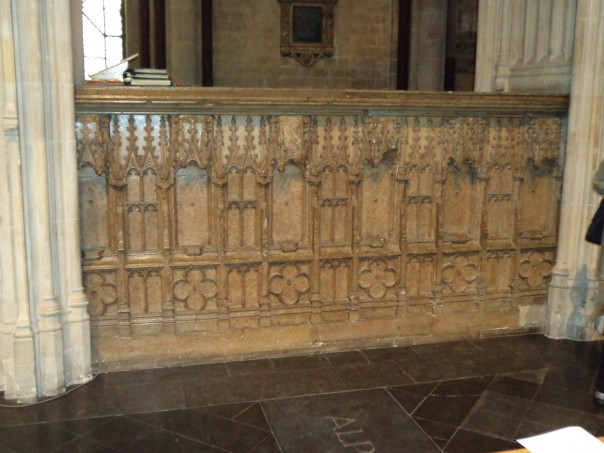
However, to return to Canterbury Cathedral and its priory, when the idea of martyrdom of the priory’s titular head is added, of course we have St Thomas, and going even further back in time, St Alphege, but we might conceivably want to add St Simon. Moreover, if we want to think about victimhood that fell short of martyrdom but where the archbishop was envisaged as ‘taking on’ wrongful or even tyrannical royal authority, it is feasible to add St Anselm and Archbishop Winchelsey.
To keep to the practicalities of having several saintly archbishops, regardless of whether they have received papal sanction, in a monastic cathedral where the daily offices were absolutely central to the religious community’s raison d’être, but which still needed to accommodate pilgrims, it is worth thinking about spatial and temporal issues. Taking the viewpoint of the various priors, separation, access, and visibility might have been envisaged as the watchwords to ensure the maintenance of the monks’ holy work, while still helping to promote pilgrimage. In this the south ambulatory was key for it can be seen as the pilgrims’ ‘highway’ to the Corona Chapel and Becket’s shrine in the Trinity Chapel (from the other 2 ‘Becket’ sites of the Martyrdom and the Tomb). Moreover, if we think about this from about 1300 onwards, the location of certain archiepiscopal tombs becomes especially telling concerning the martyred and victimised archbishops mentioned earlier. Working temporally, we can start with Archbishop Winchelsey whose opposition to Edward II (and St Augustine’s Abbey) provided the Canterbury prior with a political, but also a popular ‘saint’. At the peak of his popularity, in 1319, £90 was collected and even though it never got near to that again, the cult did last for about 50 years. Now it is worth remembering that this peak was towards the end of the Great Famine (if not the cattle disease that followed), although that would not have been clear to contemporaries, which might have attracted pilgrims to him and Canterbury, but equally was a time when the priory’s need was high to counter the agrarian disasters of its demesne farms and those of its rent-paying tenants.
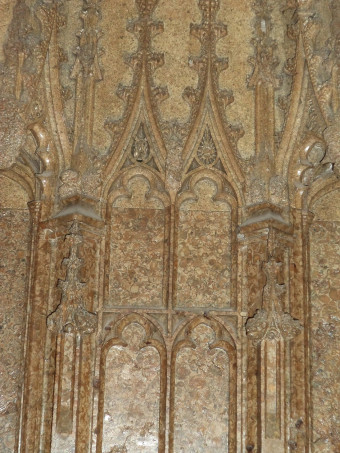
For the prior, God may have been again working in mysterious ways towards the end of Archbishop Meopham’s archiepiscopate. If Dr Alixe Bovey is right, we should see Meopham’s ‘tomb’, that forms the ‘barrier’ between the south ambulatory and St Anselm’s chapel, as having far more symbolic links to this saintly archbishop, ie a far more suitable shrine to this great scholar and theologian than a tomb for a short-lived archbishop, even if he was a university doctor. The timing is also interesting in that the early 1330s was not a good period for Kent farming, which similarly might suggest what had been seen to aid Christ’s Church earlier in the century could be brought into the equation a decade or so later.
Moving past the Black Death, and the subsequent upsurge of offerings in 1350, and presumably corresponding numbers of pilgrims to St Thomas’ shrine, Archbishop Sudbury was certainly seen as ‘a good thing’ by the priory in that he was instrumental in helping bring in donations towards the rebuilding of the nave, even if this must have turned the cathedral yet again into a giant building site.
However, for the prior this splendid shared enterprise must have felt far more precarious in June 1381 – what to do? The answer was to ensure the murdered archbishop’s body was brought to Canterbury as soon as possible, even if it was headless, and to give him a funeral monument in the south ambulatory that could become a shrine to yet another martyred prelate. Now, whereas Winchelsey and Anselm could without stretching matters too far be seen as ‘popular’, as well as officially endorsed by at least parts of the English Church, this was presumably stretching things beyond breaking point for Sudbury. Ok, there were many law-abiding peasants and townsmen who had not joined the Revolt, but that is very different to agreeing with the poll tax and other heavy impositions by the Crown, of which the archbishop could be viewed as the chief instrument and at the very least complicit. So while many may have been horrified by the manner of his death, he wasn’t St Thomas of Canterbury, the people’s champion as seen in the early lives of Becket. Yes, there were a few reported miracles and the monastic chroniclers, in particular, portrayed him as another Becket, pictorially too in Froissart’s Chronicles, but the prior might be seen to have had an impossible mission. Nevertheless, I think the priory gave it their best shot and in this the monks were supported by Canterbury’s civic authorities, who had similarly benefitted from Sudbury’s largesse. Indeed, and this is a new discovery by others, there may be further material culture associated with what I think soon became a failed cult, if it ever really took off at all beyond the monks and civic officials.
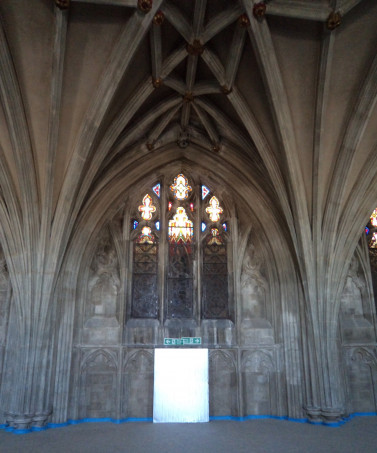
Yet, the priory cannot be faulted for trying because in addition to commemorating his obit day – 14 June, at some stage they instigated another service at his tomb on Christmas Day. The community would gather there, to be joined by the civic authorities and other (leading) citizens, where they performed orisons and prayers for Sudbury’s soul. However, things did not always go smoothly, and even this limited attempt to keep Sudbury’s tomb/shrine among the cathedral’s sacred sites was thwarted by the civic authorities during their dispute with the priory around 1500. Refusing to attend as the prior expected, the mayor and senior officials met instead at the Westgate Towers where they remembered the martyred archbishop for his good works on the city’s behalf.
This brings me to David Lowenthal and the Chapter minutes. Thus, we need to fast-forward to the late 1960s when there was a plan on the table to set up a permanent exhibition of the cathedral’s treasures, presumably in part to capitalise on the 1970 Becket anniversary, which was due to have its own exhibition. However, the Treasury scheme ran into a series of problems, both in terms of location and funding, several suggested locations met with strong opposition from various parties inside and outside the cathedral community – sponsors considered they should have a say too. Consequently, matters rumbled on for several years, thereby missing the 1970 opportunity and even though a temporary Treasury exhibition opened in the crypt in 1976, things hadn’t really been settled to everyone’s satisfaction. More talks took place in 1978 and, of course, the Chapter was heading towards a potentially another big anniversary – Simon Sudbury in 1981.
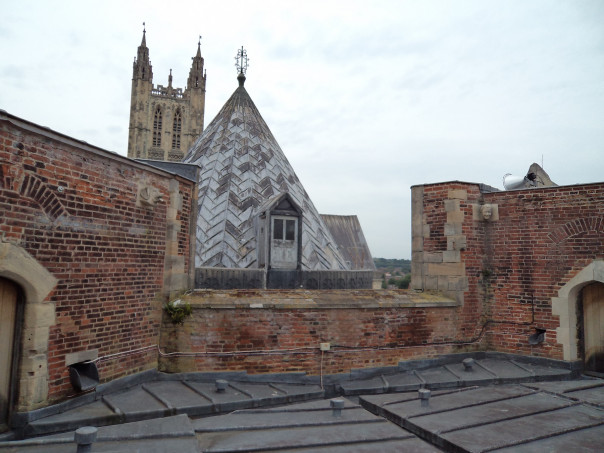
Even though it is difficult to judge from the pretty cryptic minutes, it would seem the Chapter wasn’t going to miss out this time, not least because they had been mounting a large fund-raising campaign during this period. As a result, Sudbury’s 600-year anniversary was marked by a civic service in the cathedral, special music, and a play, while the formal opening of the Treasury exhibition took place in May 1981. However, it was something else that really caught my eye in the minutes. For in December 1978 the Chapter agreed that Canon Derek Ingram-Hill would liaise with the chief executive of Canterbury City Council to arrange a revival of the Christmas Day ‘old custom’ of commemorating Sudbury. The plan was that the city councillors, who would be attending the Christmas morning service, should arrive early and process to the tomb where they were to place the Christmas Rose before going to the service. How long this continued, I don’t yet know, because today the ceremony is conducted after the morning service. I could stop here because I have solved the question of when ‘old (medieval) custom’ surrounding Sudbury was revived, but I think it is worth pondering this new (and different) ritual – what it might tell us about attitudes to the past, and Sudbury’s place in it.
Now I never had the chance to ask Canon Hill why he instituted this specific ritual and what he intended, but I want to borrow something from Lowenthal: “Refashioned in present garb, the past becomes more comprehensible or congenial.” I’m not saying I have the answer(s), but if we are ‘refashioning’ in this way, what are we saying about Sudbury as symbol, because that is complex enough without thinking of Sudbury the man. I’m going back to 1381, and, yes, “the past is a foreign country, they do things differently there”, but I’ll just put forward a few ideas – Sudbury as archbishop and chancellor of England might be envisaged as Janus, or if you prefer the idea of two hats, then two heads, which takes us to the monstrous, for even though he was the shepherd of his sheep, for the followers of John Ball he was the wolf in sheep’s clothing that would devour the sheep. At the local level, too, Sudbury’s ‘meaning’ was not straightforward. He was central to the building of the great new Perpendicular-style nave in the cathedral church of his monastic community, but that same community through its own brethren and its lay officials, was seeking to reintroduce servile conditions and use national legislation against its manorial tenants. Similarly, as ‘builder’ of the Westgate Towers and the long wall he aided the civic authorities in their reinstatement of the city’s defences against the perceived French threat. But just for a moment think about the location of this new gate – on the road to London, not Dover or any of the other Channel ports, and right on the boundary between archiepiscopal and city/civic space, as well as its use as Canterbury’s prison.
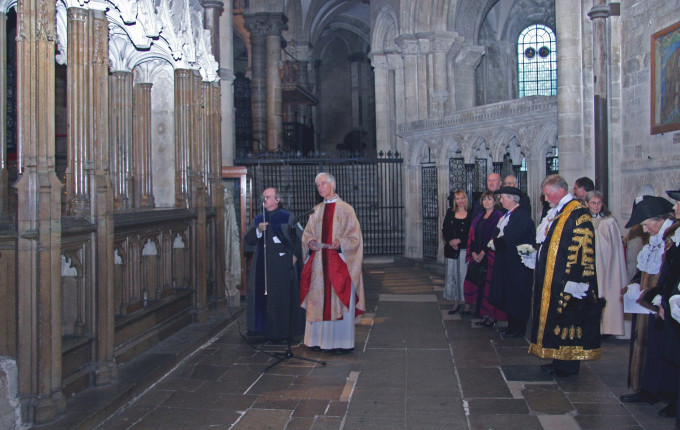
Bringing this forward to 1978 and the ‘winter of discontent’, yes, I think the ‘new (modern) custom’ does fit Lowenthal’s idea of refashioning making it comprehensible, but even more the idea of congenial. However, whether by accident or design the choice of the Christmas Rose seems somehow especially apt if we are thinking about then and now. Black Hellebore, known in former times as Christe Herb, does have a medieval legend attached regarding a shepherdess called Madelon who seeing the shepherds and wise men taking gifts to the infant Christ, cried because she had nothing to take. Her tears awakened the pity of an angel and when her tears fell to the ground the snow miraculously turned into the Christmas Rose, her gift for Christ. So far so good, a very appropriate symbol to remember Simon Sudbury’s ‘good deeds’ for city and cathedral. Yet there is more to this plant because it is highly poisonous, but at the same time was used for medicinal purposes – one of those kill or cure scenarios for various conditions and through using different parts of the plant. Consequently, this annual remembrance of a martyred archbishop, an act of commemoration for his works that continue to aid the organisations whose representatives gather at the tomb, may be worth probing a bit deeper if we are to get a greater understanding of the past and our relationship with it in the present.
 Centre for Kent History and Heritage
Centre for Kent History and Heritage Sheila Sweetinburgh
Sheila Sweetinburgh 2141
2141


Great share. Thank you